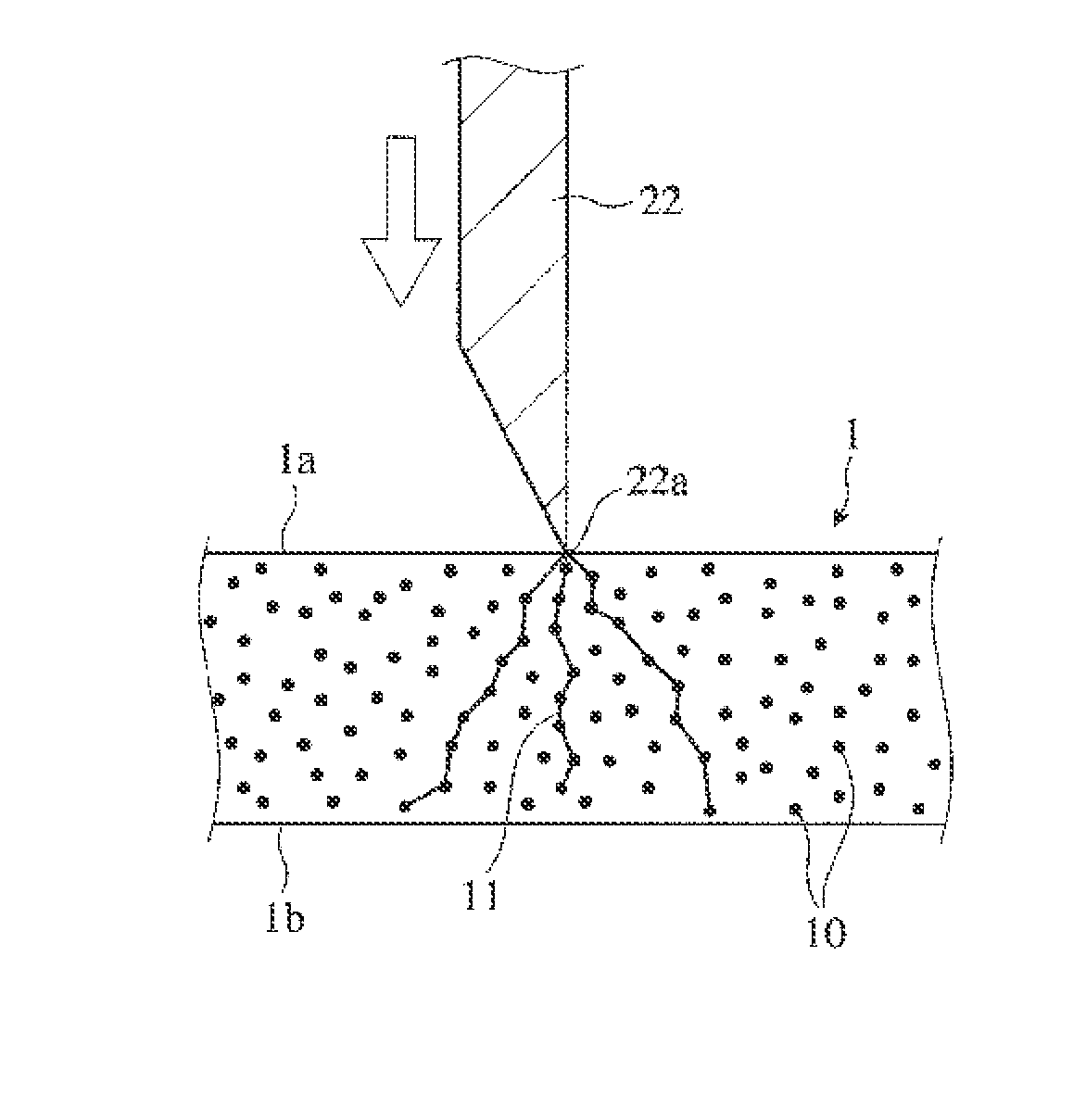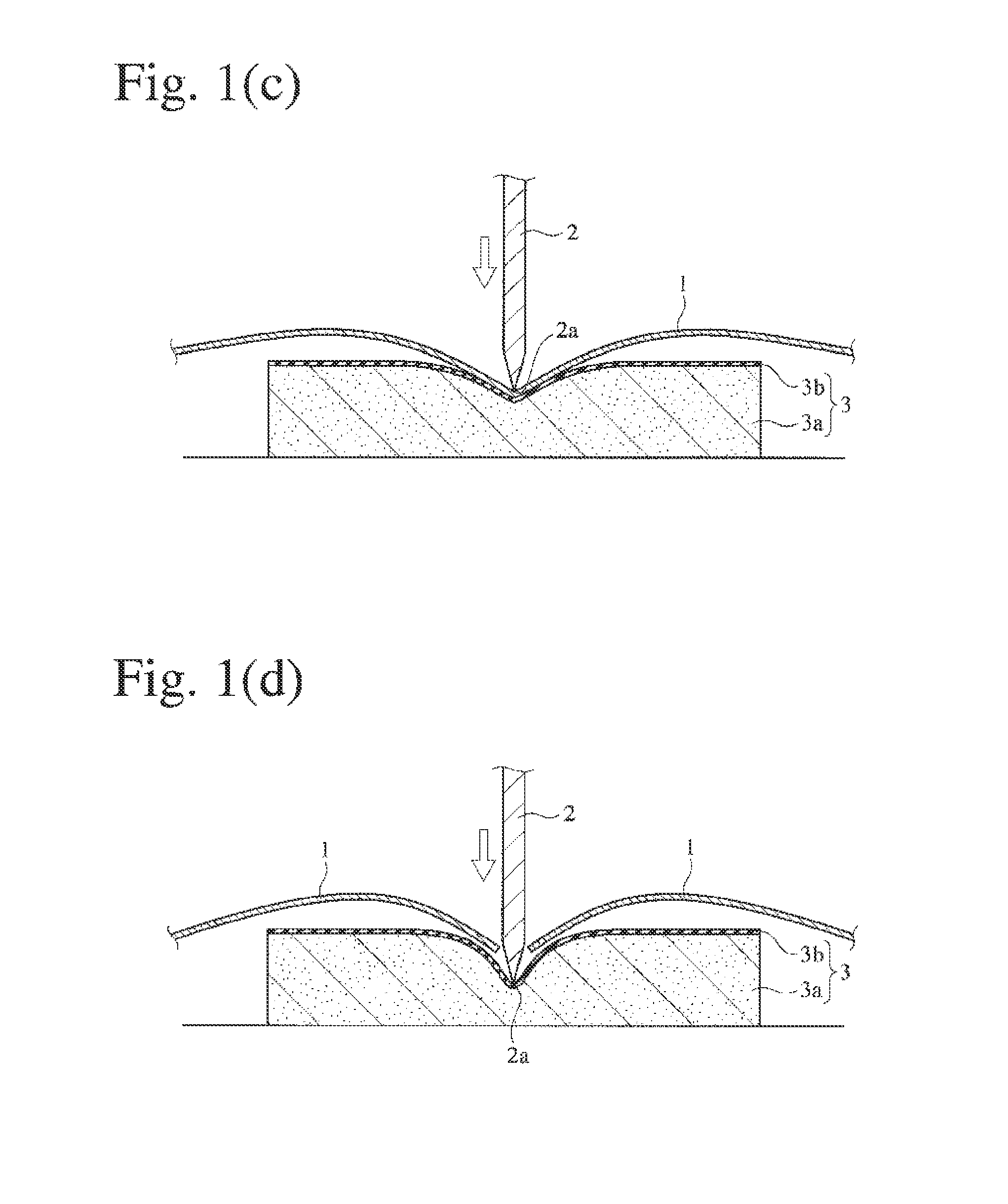Primary ultrafine-crystalline alloy ribbon and its cutting method, and nano-crystalline, soft magnetic alloy ribbon and magnetic device using it
- Summary
- Abstract
- Description
- Claims
- Application Information
AI Technical Summary
Benefits of technology
Problems solved by technology
Method used
Image
Examples
examples 1 to 8
[0112]By a single roll method using a cooling roll made of a copper alloy, each alloy melt (1300° C.) having the composition shown in Table 1 was quenched in the air, and stripped from the roll at a ribbon temperature of 250° C. to obtain a primary ultrafine-crystalline alloy ribbon of 25 mm (Examples 1 to 5) and 50 mm (Examples 6 to 8) in width. To adjust the average grain size and volume fraction of ultrafine crystal grains, and the Vickers hardness Hv of the primary ultrafine-crystalline alloy ribbon, a gap between a nozzle and the cooling roll and a the peripheral speed of the roll (27-36 m / s) were changed during casting as shown in Table 1.
[0113]As shown in FIG. 5, the thickness and Vickers hardness Hv of each primary ultrafine-crystalline alloy ribbon were measured in each measurement point line 1 to 5. The average thickness was obtained by averaging the thickness values measured in the measurement point lines 1 to 5, and the thickness difference was difference between the max...
example 9
[0133]To investigate the relation between the percentage of notches and the gap without influence of the ribbon thickness, an alloy melt having a composition (atomic %) of Febal.Cu1.4Si4B14 was formed into primary ultrafine-crystalline alloy ribbons having a width of 25 mm and 50 mm, respectively, in the same manner as in Example 1 except for changing the gap as shown in Table 12, and changing the peripheral speed of the roll to provide the resultant ribbon with a constant thickness of 21 μm. It was confirmed that each ribbon had a structure in which ultrafine crystal grains having an average grain size of 30 nm or less were dispersed in a proportion of 5-30% by volume in an amorphous matrix. Next, each ribbon was measured with respect to hardness difference between a center portion and side portions, thickness difference in a transverse direction, and the percentage of notches generated when cutting was conducted by the linear pressing method of the present invention. The results a...
example 10
[0138]The primary ultrafine-crystalline alloy ribbon of Example 3 having a composition (atomic %) of Febal.Ni1Cu1.4Si4B14 was subjected to a high-temperature, short-time heat treatment comprising heating to 430° C. in 15 minutes and then keeping that temperature for 15 minutes, to obtain a nanocrystalline, soft magnetic alloy ribbon comprising fine crystal grains having an average grain size of 20 nm dispersed at a volume ratio of 45%. Using a B—H loop tracer, this nanocrystalline, soft magnetic alloy ribbon was measured with respect to a magnetic flux density B8000 at 8000 A / m (substantially equal to a saturation magnetic flux density Bs), a magnetic flux density B80 at 80 A / m, and coercivity Hc. As a result, B8000 was 1.81 T, B80 / B8000 was 0.93, and Hc was 7 A / m.
PUM
| Property | Measurement | Unit |
|---|---|---|
| Fraction | aaaaa | aaaaa |
| Fraction | aaaaa | aaaaa |
| Thickness | aaaaa | aaaaa |
Abstract
Description
Claims
Application Information
 Login to View More
Login to View More - R&D
- Intellectual Property
- Life Sciences
- Materials
- Tech Scout
- Unparalleled Data Quality
- Higher Quality Content
- 60% Fewer Hallucinations
Browse by: Latest US Patents, China's latest patents, Technical Efficacy Thesaurus, Application Domain, Technology Topic, Popular Technical Reports.
© 2025 PatSnap. All rights reserved.Legal|Privacy policy|Modern Slavery Act Transparency Statement|Sitemap|About US| Contact US: help@patsnap.com



